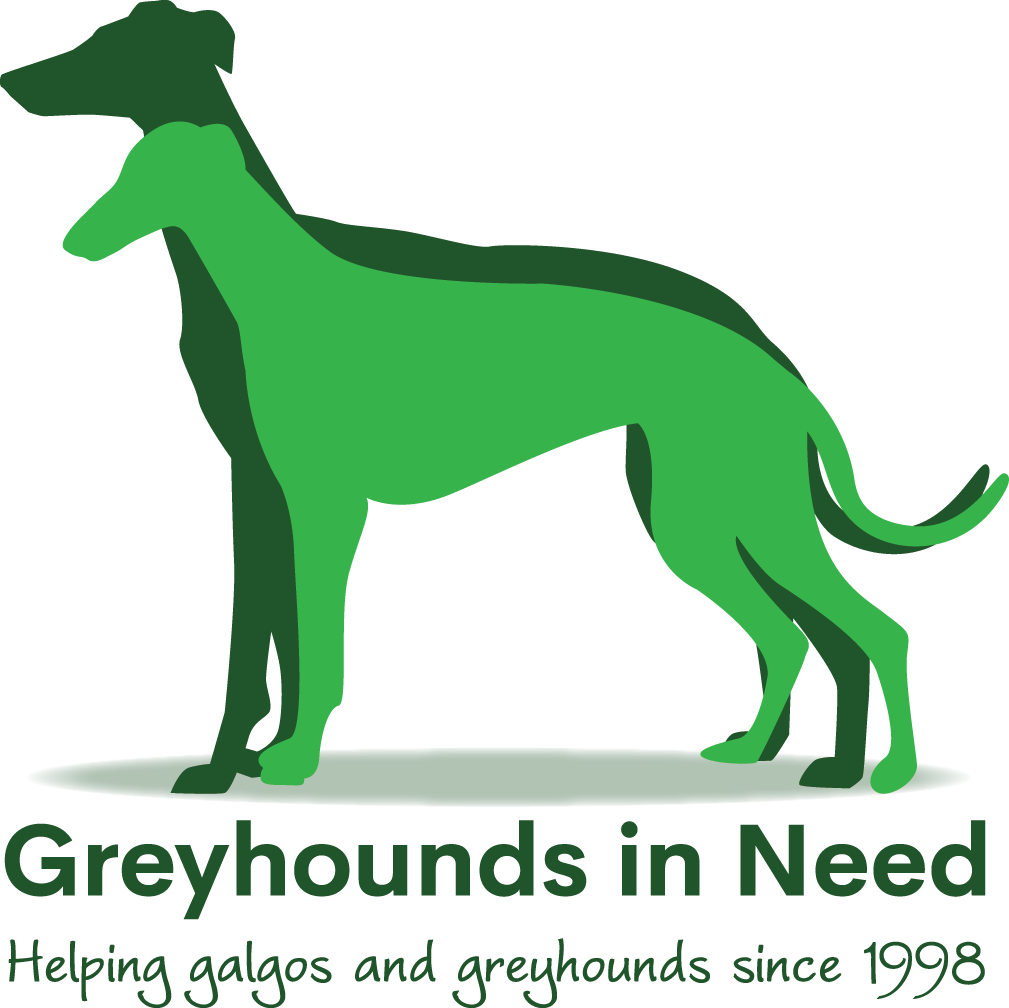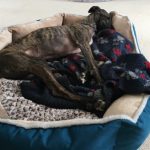Now that you’re close to adopting a galgo here’s a few ideas about what you’ll need to think about before you bring your new dog home.
Galgos are big couch potatoes so let’s first look at beds as they’ll spend a fair bit of their day snoozing. They need soft beds as they don’t have much padding on those slender bones so my dogs have always favoured a soft-sided bed. These come in different shapes, sizes, styles and colours and of course various prices so it’s a good idea to shop around. You will need to look at large or extra-large sizes depending on the style and make. The inside measurement of the beds pictured is a minimum 80 cm in length.
My two galgos have spent many hours road testing the beds pictured! Some beds have zip-off covers, some don’t so you’ll see that I like to add thick fleece blankets for my dogs. There are a couple or reasons why; one is they like to snuggle, especially in the winter, the other reason is hygiene. Washing a fleece blanket regularly is much easier than trying to wash the whole dog bed.
When positioning a new bed it’s important to allow for natural spillage!
Another really useful type of bedding is Vetfleece. This is a type of thick fleecy mat that is easy to wash. They come in lots of colours and sizes with the option of anti-slip backing. They have many uses, perfect if you have lots of tiled, wood or laminate flooring, great in the back of the car or on the backseat, easily rolled up and carried to visit a friend or out on the patio and ours have made several trips out to the local pub. The mat pictured is 30” x 40” and this seems to work well.
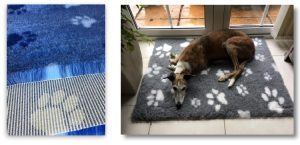
You’ll need to think about where your galgo will eat and drink and buy suitable feeding bowls. We recommend a raised feeder as it gives a much more comfortable feeding position for your long-legged friend. The feeder keeps the bowls firmly in place no matter how well-licked they are! I’ve added a picture here of the style I use so you see what I’m talking about. Again there are lots of styles and choice but this particular one works well and I think is an ideal height. It’s called a Savic Ergo Feeder and you will need a large size. Pets at Home usually stock this but again shopping around is always good.
In kennels, your galgo will be fed on a good quality kibble mixed with some wet food twice a day. We can advise you of the make of food near to adoption day and would suggest that you feed the same diet for a few weeks while your galgo settles in before you consider changing brand should you wish to do so. Please always do this slowly over a period of at least a week increasing the proportion of the new food slowly so there’s less chance of an upset stomach.
At last, the day arrives when you finally get to meet and hopefully adopt your galgo but you need to decide beforehand how your dog will travel home in the car. Whether you have a nice big boot or you intend the dog to travel on the back seat you should bring along some sort of bedding so they feel comfortable and secure. On this important first journey home and so that there are no ‘escapees’ as you open your boot or door on arrival, we strongly suggest that a harness is used. GIN does have car harnesses available to purchase that clip into the seat belt so that the dog can’t jump out unexpectedly and these will be available on the day. This is great for use in the car but in my experience, these are not a good enough fit to be used for general walking. So I’d like to show you a couple of alternative types that will be very useful in both travelling and walking your dog safely.
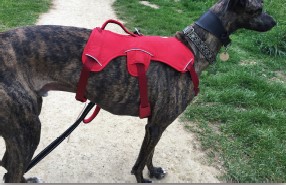 As a rescue many of the galgos are a bit nervous in the early days, after all, they’ve never been in a home before or experienced many of the sights and sounds that we will expect them to cope with. They can react very quickly if taken by surprise, leaping about with excitement or pulling back in fear. This is where a harness is so useful. When fitted correctly a harness is comfortable for the dog but also gives you secure control, much safer
As a rescue many of the galgos are a bit nervous in the early days, after all, they’ve never been in a home before or experienced many of the sights and sounds that we will expect them to cope with. They can react very quickly if taken by surprise, leaping about with excitement or pulling back in fear. This is where a harness is so useful. When fitted correctly a harness is comfortable for the dog but also gives you secure control, much safer
than only using a collar where all the force is on the neck. Greyhounds are well known for slipping out of a standard greyhound collar as they have
very slim heads!
The red harness that Reuben is wearing (left pic, Ruffwear Web Master Harness), has an extra strap under the belly and this style is called a 3 point harness. This type has proved to be very effective and it would be almost impossible for your galgo to escape from this. These are frequently used by GIN and the rescues in Spain. The other type that works well with the galgos is a Cosydogs fleece lined harness (right pic). Not a 3
point type so if you have a dog who pulls back hard it is possible that they can wriggle out, I know from experience! But they are still very good and
work well with most dogs. Once the dogs arrive I will be able to let you know what size you will need if you’re interested in purchasing one.
 Both types of harness have a strong ring on the back where you attach your lead and when travelling by car you can buy just a strap attachment that either plugs into the seat belt clip or one that secures around the headrest. This is the type I use shown here. Only ever attach this security strap to a harness never to a collar as it could cause serious injury if you were to brake suddenly.
Both types of harness have a strong ring on the back where you attach your lead and when travelling by car you can buy just a strap attachment that either plugs into the seat belt clip or one that secures around the headrest. This is the type I use shown here. Only ever attach this security strap to a harness never to a collar as it could cause serious injury if you were to brake suddenly.
One other item I successfully use with a harness is a long 5-metre lead. I don’t personally like the retractable types as I find them too easily pulled from your hand if your dog reacts quickly and can then be a hazard. Using a long line gives you and your dog more freedom whilst on a park walk. It’s long enough to start to practice a bit of recall but not too long to get all tangled up in!
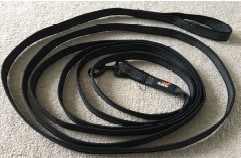
As galgos have very little body fat and very thin natural coats, the next item on your shopping list will be coats. You will need two; galgos definitely don’t like rain, so a thin raincoat for those wet days and a warm lined winter coat for when the temperatures drop are essentials. These will get you started and there are many more variations that may be useful like a hi-vis coat if you will be walking in the dark during those winter months or an indoor fleece for nighttime if you don’t have your heating on but I suggest you start with the basics and you’ll soon work out what else you need. Galgos like greyhounds are a specific body shape so you’re very unlikely to find the right coats at your local pet shop. You will be able to find them online, but GIN does sell a nice range of well-priced coats, and of course, every purchase from GIN helps towards the charity’s aim to support the welfare, rescue, and rehoming of the Spanish Galgo.

Obviously, you won’t know the size of coat you will need beforehand but we will be able to help with that on adoption day and we’ll have a selection of the GIN coats at the kennels that can be fitted and purchased if you wish to do so. A sample of what’s on offer is in the pic above but you can look at the full range and other GIN merchandise by going to the GIN shop.
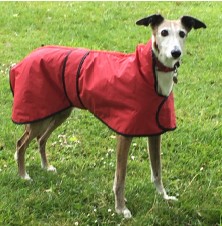
Flossie modelling one of GIN’s raincoats whilst squirrel watching.
You’ll notice that there are different types of collars pictured above. When adopted your galgo will go home with a standard leather greyhound collar, fitted with a GIN ID tag, matching leather lead, and a greyhound muzzle. Another collar we strongly recommend that you use is a house collar.
The house collar should be fitted loosely around the neck and should also have an ID tag attached and it can be left on all the time. This way you can remove the walking out collar when indoors making it more comfortable for your galgo but you’ll always have something to get hold of if you need to guide your dog away from something or maybe hold onto as you answer the front door for example. Don’t underestimate how quick they can be slipping past you if they spot the neighbour’s cat as it strolls past unexpectedly! I must add that a house collar should not normally be used with a lead as they are too narrow to be suitable for your galgos neck.
You will need to get ID tags made with your contact details on as by law your dog must wear a collar with a tag when out in a public place and of course if lost can hopefully be reunited with you quickly. I don’t put my dog’s names on their tags as it can be used to entice them away but that is my personal preference.
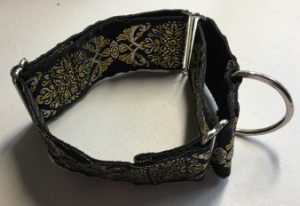 The other type of collar pictured is a Martingale. If you’ve had a greyhound, galgo or lurcher before you may have used this type. They are popular with hound owners because they prevent the dog from slipping out from the collar as when pulled the collar tightens around the neck.
The other type of collar pictured is a Martingale. If you’ve had a greyhound, galgo or lurcher before you may have used this type. They are popular with hound owners because they prevent the dog from slipping out from the collar as when pulled the collar tightens around the neck.
However, it’s very important that a martingale collar is adjusted correctly or it can have a strangling effect. My personal view is not to start with this type of collar and to wait and see how calm or excitable your dog may be. Also, I would never leave a martingale collar on when
the dog is left alone as I have heard of incidents where dogs have managed to get hooked up by the ring on the collar and hurt themselves in their panic to get free.
The next thing to consider is Pet Insurance. We strongly recommend you take out insurance as a trip to the vets can quickly get expensive. I’m often asked who is good and there are many companies out there but I can only offer suggestions from my own experiences. This of course doesn’t mean they are the only good ones! Over the years I have successfully used, Pet Plan, More Than, Direct Line and currently Bought By Many. So best to compare carefully and make sure to read exactly what’s covered as they usually offer different levels. I’d also ask for recommendations from family or friends and that’ll give you a good starting point. Look for Galgo Espanol, Spanish Greyhound, Spanish Galgo, or if looking at Direct Line Spanish Hunting Dog on their breed lists if you’re going online to compare quotes, if not you will have to choose Greyhound for this exercise. Although you won’t know the exact details of your new dog yet it’s worth doing the research now so that you can get the insurance set up
as soon as you’ve adopted. Most of them have a two-week period before they offer full cover.
One more thing to be aware of if you’ve not owned a dog before is that some foods are harmful for dogs to eat, here are a few of them; Onions, Chocolate, Macadamia Nuts, Corn on the Cob, Avocado, Artificial Sweetener (Xylitol), Alcohol, Cooked Bones, Grapes, and Raisins. More detailed information is freely available on the internet. [Read our Vet’s Corner article here].
Well, I hope that answers some of your questions and gives you a few ideas of what to look at in preparation for your galgo’s arrival. If you have any more questions please email me at flossie49@gmail.com and I’ll do my best to answer them.
P.S Don’t forget to stock up on poo bags!
Thanks for reading,
Sue ‘The Homing Lady’ for Greyhounds in Need
